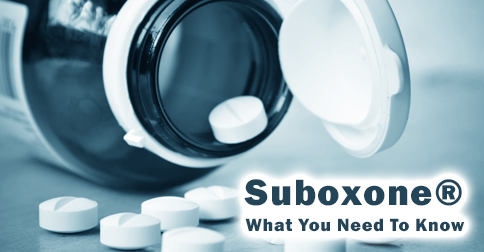Suboxone® – What You Need to Know
Physicians use Suboxone® as a pain reliever. However, some try to treat one form of addiction (such as heroin) by substituting dependence on Suboxone®. Unfortunately, most physicians don’t realize that Suboxone® is more highly addictive than traditional opiates. This means that trying to break Suboxone addiction is even more difficult – and the withdrawal symptoms are more severe – than breaking your original dependence.
You need to know that trading one opiate drug for another is never an acceptable treatment.
Pharmaceutical literature reports many side effects from using Suboxone®. Those side effects include drowsiness, dizziness, weakness, constipation, headache, nausea, or vomiting, slow and shallow breathing, mental and mood changes, depression, stomach/abdominal pain, dark urine, yellowing eyes and skin, vision changes. In addition, the literature lists allergic reactions that include a rash, itching, swelling, severe dizziness, and trouble breathing.
The medical staff at the Rapid Drug Detox (RDD) Center records patients reporting additional symptoms, including profuse sweating, decreased libido, lack of motivation, sadness, low energy levels, decreased hormonal levels such as decreased testosterone in men and estrogen in women, decreased muscle mass, tone and strength, lack of zest for life, apathy, feeling hopeless, and urinary retention.
And, the Alberta Health Services warns, combining some substances (such as heroin, morphine, codeine, oxycodone), benzos, tranquillizers and sleeping pills (such as Valium©, Librium©, Ativan©, Xanax©) with Suboxone® can lead to overdose and death. Also, drinking increases your risk of an overdose.
Yet doctors in Canada continue to prescribe this drug for withdrawal/addiction, never telling you that it, too, is addicting.
Suboxone® / Subutex / Buprenorphine withdrawal can be painful. Withdrawal symptoms typically start within 36 hours of your last use and can last over five weeks. Those symptoms include severe anxiety, sweating, malaise, depression, cramp-like pains in the muscles, leg kicking (as your body tries to “kick the habit”), severe and long lasting sleep difficulties (insomnia), diarrhea, goose bump skin (“cold turkey”), cramps, abdominal pain, dehydration, convulsions, fever and thoughts of suicide.
The symptoms of a “cold turkey” withdrawal can be so pronounced, intense, and uncomfortable that many patients revert back to their original drug use. Many have said that Suboxone® withdrawal is worse than it would be for their original opiate.
The answer waits just across the border: Rapid Anesthesia Suboxone® Detox
Fortunately, the Rapid Drug Detox (RDD) Center, just across the border, developed the RDD Method™ for Suboxone® detoxification. This medical procedure takes place under anesthesia, and that eliminates most of the withdrawal symptoms. After a brief, painless series of tests, you’ll be admitted to the operating room (O.R.). There, an experienced, board certified anesthesiologist gives you a medication to relax, and then administers a light, general anesthesia, while you rest comfortably for approximately 60 minutes. While you rest, a team of experienced doctors “scrubs” the opiate receptors in your body, using an infusion of intravenous medications.
With the Suboxone® removed from your receptors, the worst of the withdrawal is over. And you’ve slept through it all.
While in the O.R., some patients elect to begin Naltrexone Therapy, so that the opiate drugs don’t re-attach to your “clean” receptors. In that case, while you sleep, Center physicians either place a small pellet just under your skin or administer a Sustained Release Injectable “IM” Shot. With the Naltrexone medication in your system, opiate drugs don’t re-attach to your “clean” receptors.
Note: Either the Naltrexone pellet delivery system or the Naltrexone injection is mandatory for Methadone and Suboxone®/Subutex patients. That’s because these drugs have a long “half-life,” which means that they hang in your system a long time. Only Methadone and Suboxone®/Subutex patients must choose either the 30-day Naltrexone injection or 90-day pellet delivery system, but every patient can choose them for the freedom they give.
All patients leave the Center with a year-long prescription of Naltrexone to fill at your local pharmacy. Donald MacPherson, executive director of the Canadian Drug Policy Coalition, believes that wider use of Naloxone in Canada could measurably reduce overdose deaths.
After the procedure, you recover under direct medical supervision. The RDD Center team of experienced medical professionals monitors your vital signs and your overall physical and mental reactions. In the days that follow the procedure, you may sleep more than usual.
Administered by experienced, medical professionals as part of a long-term drug-addiction recovery strategy, the RDD Method™ has proven to be significantly more effective (and more cost-effective) than older methods. You can call the RDD Center at 1-866-399-2967 or contact them to learn more about beating Suboxone® addiction.
Because patients who undergo RDD treatment leave the Center clean and free of any opiates, they are free of their addiction and their former cravings. If you’re considering detox treatment, it’s important to question any treatment centers you’re considering. Learn the truth about their programs. Trading one opiate drug for another should never be an option.


